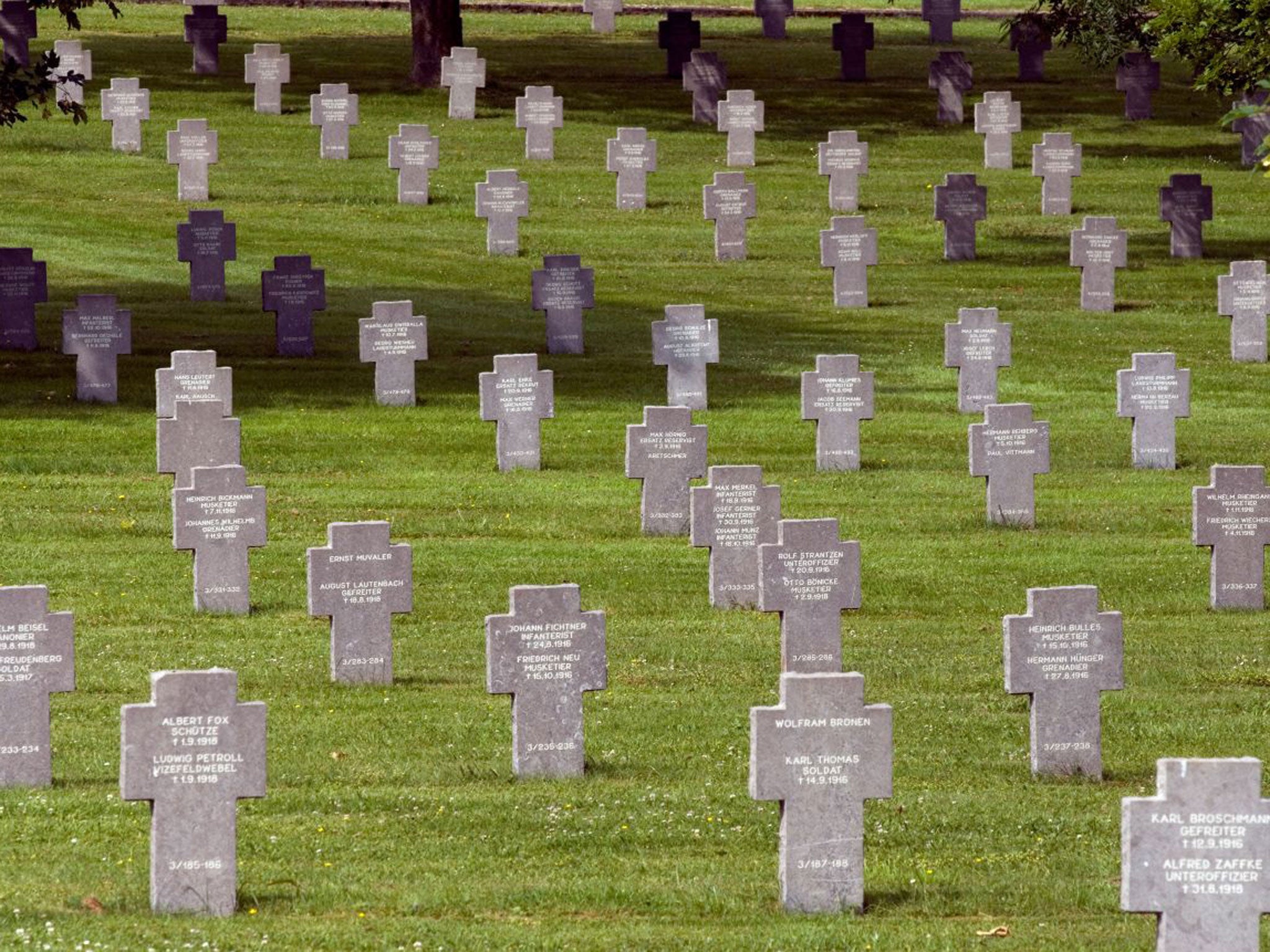The cemeteries of the Western Front are testament to the worst and best of humanity
They represent unbelievable tragedy, but their maintenance helps us remember

And so it was that, last week, 98 years to the day, I was standing in a spinach field in Northern France with my father and aunt, listening to an account of how my grandfather, Lieutenant Richard Millard, aged 19, led his company of 180 men from the Second Border Regiment over the top on the first day of the Battle of the Somme.
The sun shone, the larks sang, someone a mile or so off blew a First World War whistle. After we had wiped our eyes, and folded up Lt Millard’s trench map our guide, Neil Pudney, a man with an encyclopaedic knowledge of the conflict, led us out of the spinach field and into a nearby British cemetery. Not to see the grave of a relation, but to simply inhabit its extraordinarily powerful atmosphere.
We spent three days on the Western Front, and visited many such cemeteries. We walked alongside the graves of Newfoundlanders, Maoris, English brothers, Scotsmen, Australians; almost the entire Devonshire regiment. All were astonishing, not only for what they told, but also for the manner in which it was told, thanks to the Commonwealth War Graves Commission.
The War Graves Commission, whose centenary anniversary it is this year, is one of those unheralded but remarkable British institutions. It began in 1914 as the Mobile Ambulance Unit under one Fabian Ware. Quite a chap, was Ware. He felt the dead ought to be recorded and acknowledged, but also remembered. “He was a socialist imperialist,” explains the journalist and current War Graves commissioner Robert Fox. “He decreed that not only should the dead be buried close to where they fell, but that the style of how they were buried should be the same. Irrespective of rank. So the bombardier would be buried next to the brigadier.”
Amazingly, given the chaos and carnage of the First World War, Ware also put a very high consideration on art. With the help of Sir Frederic Kenyon, director of the British Museum, Ware decided to hire the most eminent artists of the day. He called upon Edwin Lutyens to design the Stone of Remembrance for cemeteries with more than 1,000 graves. Lutyens also designed the individual headstones, which are all identical, and all made from white Portland stone. Ware then called upon the most famous writer of the day, Rudyard Kipling, to compose a suitable line for the graves of the anonymous. “Known Unto God”, Kipling’s line, was carved on tens of thousands of headstones.
Lutyens, who went on to build the vast (yet untriumphal) war memorial at Thiepval, and the Cenotaph, collared two of his distinguished colleagues, Herbert Baker and Reginald Blomfield, to design the structures for each cemetery. And his muse and ally Gertrude Jekyll was to organise the planting, which she decreed must be like an English country garden. All year round. So that British soldiers would be eternally surrounded by the flowers they might have grown up with.
Ware’s vision has not only lasted; it has deepened. Today, as you walk through the cemeteries on the Western Front, and as personal ties fade, they stand as dignified testimonies to the power of art and restrained sentiment, as well as being what George V in 1922 called “a potent advocate of peace”. Thanks in no small part to the Commonwealth War Graves Commission, they are in perfect condition.
The grass is immaculate; the flowers are blooming as Jekyll ordered them to be; the cool white Portland headstones are in perfect symmetry, bounded by the warm redbrick of the Arts and Crafts style walls of the perimeter. Should it fade, Kipling’s great line is sharpened up by the Commission, which re-engraves 20,000 stones a year at a special workshop in Arras. Anyone studying English art and aesthetics could do worse than go to the cemeteries on the Western Front.
The Commission, which marks 1.7 million graves in 153 countries, announced yesterday it is to put all the records for the fallen, including telegrams and memorabilia, online. But its most lasting work, I think, is the astonishing maintenance of the Western Front cemeteries, as they mutate into something equating a communal expression of humanity.
Giving up on a book is fast becoming a summer tradition
We don’t read our summer books, do we? Slap on the wrist for R Millard, who has optimistically bought The Goldfinch – named and shamed as one of the weighty tomes which we are all going to haul to Cornwall or Tuscany and then ignore for two weeks while we play on Twitter. It is, of course, the fault of things like Twitter, giving delight in 140 characters and also the chance to look at pictures of hedgehogs, which have dented our appetite for 900-pagers.
Hillary Clinton’s memoir is also up there, as is that thing by Piketty which, I admit, I have been tempted by. An American academic (of course) has identified how to spot these unread bestsellers. They are the ones revealed by Kindle as having loads of favoured highlights in the first 50 pages only.
Well, Prof, maybe the first 50 pages are the best ones. As someone who is in the 12.3 per cent of readers estimated to have actually got to the end of the world’s most famously unread bestseller, Stephen Hawking’s A Brief History of Time, I would like to agree with this. Except I can’t remember much about the book bar finishing it.
Join our commenting forum
Join thought-provoking conversations, follow other Independent readers and see their replies
Comments